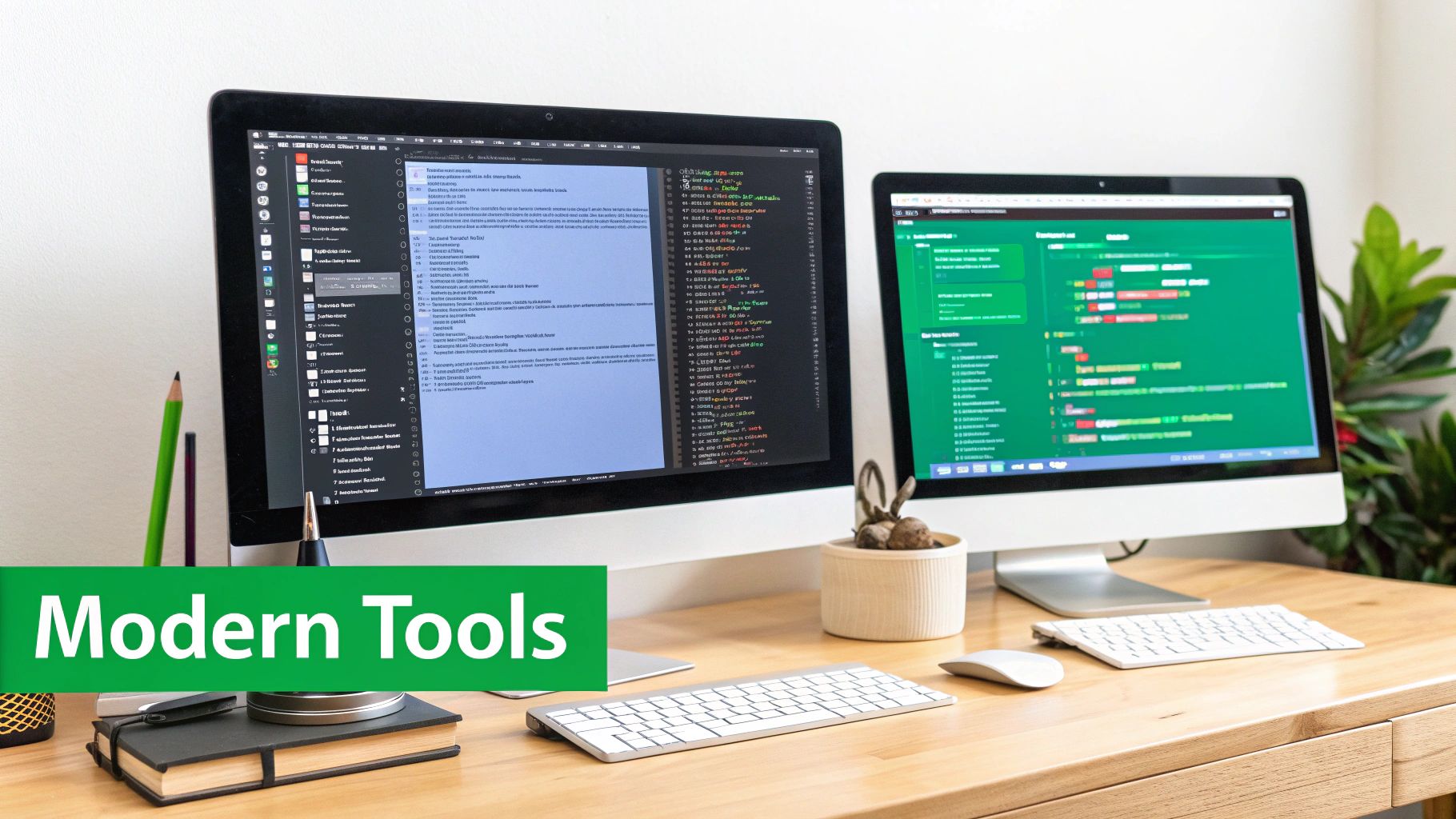Discover data-driven strategies to improve developer productivity and streamline your team's workflow for lasting success.

Traditional metrics like lines of code and commit counts often miss the mark when it comes to measuring true developer productivity. These numbers can be easily inflated and don’t always reflect the quality or impact of the work. Focusing too much on these narrow definitions can foster a culture that values quantity over quality, ultimately hindering innovation and impacting team morale. What really matters is the effectiveness of the development work itself.
Measuring developer productivity is a complex challenge. Common metrics like commit count and lines of code changed have a limited relationship with actual effort. Studies using Diff Delta showed a correlation of up to 61% in some cases, yet these metrics don’t tell the whole story. This points to the need for a more comprehensive approach, considering both quantitative and qualitative factors to accurately assess and improve developer productivity across different projects and teams. For a deeper dive into developer productivity measurement, check out this guide: Measuring Developer Productivity: A Comprehensive Guide for the Data-Driven.
High-performing engineering organizations understand that developer productivity is about much more than just code output. They take a broader view, incorporating elements like:
This shift recognizes the multifaceted nature of software development and the importance of human factors in achieving optimal results. A developer consistently delivering high-quality, impactful code is far more valuable than one producing a high volume of buggy or irrelevant code.
To better illustrate the limitations of traditional metrics and the importance of a holistic approach, let’s look at the following comparison:
Common Productivity Metrics and Their Limitations: A comparison of frequently used developer productivity metrics, showing their strengths, weaknesses, and correlation with actual productivity.
This table highlights the limitations of relying solely on easily quantifiable metrics. While helpful in certain contexts, they must be considered alongside qualitative factors to paint a complete picture of developer productivity.
To truly measure and improve developer productivity, we need to look beyond simple quantitative metrics and embrace a more nuanced approach. This involves considering factors like:
These qualitative factors, while harder to measure directly, offer invaluable insight into a developer’s actual contribution to the team and organization. By incorporating these aspects into our understanding of productivity, we create a more supportive and efficient development environment. Tools like DocuWriter.ai can free up developer time spent on documentation, allowing them to focus on more strategic and creative work. This directly boosts productivity by reducing tedious tasks and allowing developers to concentrate on core development activities, strengthening project outcomes and contributing to a more streamlined development process.

Truly understanding developer productivity relies on more than just intuition. It requires data. High-performing engineering teams use activity data to identify bottlenecks, optimize workflows, and eliminate friction. This isn’t about micromanagement. It’s about empowering developers to work smarter, not harder.
Collecting data shouldn’t feel like being watched. The key is transparency and a clear purpose. Openly communicate why data is being collected, what specific metrics will be tracked, and how the information will be used to improve the development process. For example, tracking time spent in different stages of the development lifecycle can reveal inefficiencies without singling out individual developers.
Involving developers in selecting the metrics is also crucial. Their input ensures the data collected is relevant to their daily work and addresses their actual pain points. This collaborative approach builds trust and makes developers active participants in improving their own productivity. Data becomes a tool for improvement, not a source of stress.
Collecting data is just the beginning. The real value lies in interpreting that data and translating it into actionable changes. Improving developer productivity often involves analyzing large datasets of coding activities. One study, for instance, analyzed 878,592 dev-years to determine the median annual commits for developers across GitHub. This type of data provides valuable insights into how developers work and what factors contribute to their productivity.
Further analysis of 12,638 pull requests revealed an efficiency increase of 22-31% with certain strategies. This highlights the significant potential for improvement through strategic planning and effective tool usage. These detailed analyses are essential for optimizing workflows and enhancing team performance. Learn more about measuring developer productivity here. You can also find a broader overview of this topic in this article: How to improve developer productivity.
Data analysis can uncover patterns that predict future productivity roadblocks. For example, consistently long code review cycles might suggest a need for clearer coding standards or improved tooling. By identifying these patterns early, teams can proactively address problems before they negatively affect project delivery.
This proactive approach can include adopting tools like DocuWriter.ai to automate documentation, freeing up developers to concentrate on coding. By eliminating tedious tasks, tools like DocuWriter.ai can directly boost efficiency and job satisfaction.

The work environment significantly impacts developer productivity. Both physical and digital spaces play a key role. Creating an environment that promotes focus and collaboration is essential for producing high-quality code. This means considering factors like interruptions, noise levels, meeting schedules, and how teams work together.
These seemingly small details can greatly influence a developer’s ability to think clearly, especially when working on complex tasks.
Interruptions are a major obstacle to developer productivity. Even a single interruption can disrupt a complex train of thought, and it can take a considerable amount of time to regain focus. One strategy for minimizing disruptions is implementing “focus time” blocks. During these periods, meetings and communication are kept to a minimum.
Tools like DocuWriter.ai can automate tedious documentation tasks, freeing developers to concentrate on coding. This not only boosts productivity but also reduces frustration and the risk of burnout.
However, minimizing disruptions shouldn’t mean sacrificing effective communication. Teams need to strike the right balance. Asynchronous communication tools, such as project management platforms and shared documents, can facilitate information sharing without constant interruptions. This allows developers to stay informed while maintaining their concentration.
The ideal workspace setup can vary depending on the task. Deep work, such as complex coding or debugging, often benefits from quiet, isolated spaces. Collaborative problem-solving, however, may thrive in more open and interactive environments. Offering a variety of workspace options, from private offices to collaborative hubs, empowers developers to choose the setting that best suits their current needs.
This flexibility can significantly improve both individual focus and teamwork. For example, providing noise-canceling headphones or dedicated quiet rooms can create a haven for focused work. Conversely, well-equipped meeting rooms with interactive whiteboards can encourage productive collaboration.
Creating an environment that supports both deep, focused work and collaboration is key for maximizing developer productivity. This involves not only the physical workspace but also the digital tools and processes teams use. This balance can be achieved through strategic scheduling and thoughtful workspace design.
Setting aside specific times for focused work and others for collaboration helps developers switch gears effectively. Optimizing the development toolchain is another important factor. Tools like integrated development environments (IDEs), version control systems, and automated testing frameworks should be streamlined and integrated to minimize friction in the development process. Using a tool like DocuWriter.ai for automated documentation further reduces context switching, allowing developers to stay focused on coding.
Many high-performing teams have significantly improved their productivity by optimizing their environments. Some common practices include:
By prioritizing both the physical and digital workspaces, teams can create an environment where developers can thrive and produce their best work. Tools like DocuWriter.ai play a crucial role in this optimization process, automating tedious tasks and allowing developers to focus their energy and creativity on the most impactful aspects of software development. This results in greater efficiency, improved code quality, and increased developer satisfaction.

The right tools can dramatically improve how much your developers get done. A well-optimized development toolchain reduces distractions and eliminates tedious roadblocks, allowing developers to concentrate on building great software. This section explores how strategically improving your toolchain can create a ripple effect of productivity gains.
The first step to optimization is knowing where you stand. Identify the bottlenecks slowing down your team. This typically involves analyzing your current workflows and getting feedback from developers about their frustrations.
For example, are slow build times a constant headache? Is debugging a difficult and time-consuming process? Are your developers stuck using outdated or incompatible tools?
Fixing these issues can lead to significant improvements in productivity.
Once you’ve pinpointed the bottlenecks, focus on tool improvements with the highest potential return on investment (ROI). This might mean upgrading your Integrated Development Environments (IDEs) for better performance and features, or adopting more robust testing frameworks to reduce debugging time.
Improving version control processes can also save a lot of time and effort. Think about the tools most critical to your team’s daily work and where upgrades will make the biggest difference.
For example, automating repetitive tasks with tools like DocuWriter.ai can free up significant developer time.
A well-integrated toolchain allows developers to move smoothly between different tasks. This means automating the transitions between stages of development, from writing and testing code to deployment and monitoring. Your tools should integrate together smoothly, minimizing distractions and keeping developers focused.
For example, connecting your IDE with your version control system (Git for example) and Continuous Integration/Continuous Delivery (CI/CD) pipeline can create an efficient, automated path from writing code to releasing it. For more helpful information, take a look at this guide on developer productivity tools.
Upgrading tools can disrupt workflows if not done carefully. A phased rollout, starting with a small group of developers, allows for testing and troubleshooting before a wider release. This minimizes disruption to ongoing projects and allows for a smoother transition.
Training on new tools is also essential to ensure developers can use them effectively and are on board with the changes.
After upgrading your toolchain, track its impact on productivity. Consider measuring metrics like:
Let’s look at a summary of potential impacts in the table below.
Productivity Impact of Development Tool Optimizations
By tracking these metrics, teams can demonstrate the value of toolchain optimization and make informed decisions about future improvements. Continuously evaluating your tools and processes ensures your development environment is always set up for maximum productivity and a happy team.
Motivating developers to consistently perform at their best requires understanding what truly drives them. While a competitive salary is important, it’s not the only factor. This section explores the crucial relationship between compensation, recognition, and sustained productivity, drawing insights from engineering leaders and talent retention experts.
Competitive compensation is the foundation of any effective reward system. Understanding market benchmarks for developer salaries across different roles and regions is essential. This knowledge helps companies attract and retain top talent. For example, a Senior Software Engineer in San Francisco might earn a significantly different salary than someone in a similar role in Bangalore. Additionally, specialized skills in areas like AI/ML or cloud computing can impact compensation expectations.
However, simply offering the highest salary isn’t always the best strategy. Developers also value the structure and transparency of their compensation. Clearly defined salary bands, performance-based bonuses, and equity options can create a sense of fairness and opportunity, motivating high performance.
Beyond monetary compensation, recognizing developers’ contributions is crucial for sustaining productivity and a positive work environment. Effective recognition goes beyond verbal praise. It can include:
These initiatives boost morale and contribute to long-term retention. Feeling valued and appreciated is a powerful motivator, fostering engagement and high performance.
Creating a reward system that drives sustainable performance requires a strategic approach. This means aligning individual contributions with organizational goals and market conditions. One effective strategy is linking rewards to measurable outcomes, such as:
It’s also important to consider economic factors. Developer productivity can be influenced by broader economic trends. Between January 2018 and January 2024, the median base pay for developers grew by 24 percent, while overall U.S. worker pay grew by 30 percent. This data suggests a competitive market where developers remain well-compensated. Learn more here. Understanding these trends helps developers and companies make informed decisions.